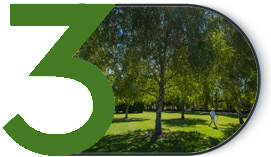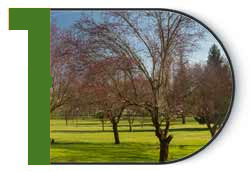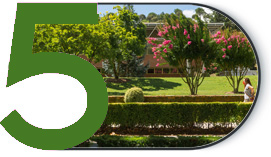Living Labs
Today's environmental challenges require innovative and collaborative solutions. That is why the University of Navarra has launched the project "Living Labs" with the purpose of promote the partnership between students, researchers, companies and society to co-create innovative solutions that promote sustainability and efficiency in the Campus University.
This project seeks to address environmental and social challenges through the implementation of several lines of research that focus on areas such as air and water quality monitoring, biodiversity enhancement, waste valorization, and the promotion of urban agriculture.

River monitoring: Sadar River
It focuses on monitoring the waters of the Sadar River as it crosses our university campus . To determine its status and possible impacts, three types of actions will be carried out.
→ Physicochemical analysis
Thanks to the state-of-the-art equipment for water analysis owned by Biodiversity and Environment Institute (BIOMA), parameters such as pH, temperature or pollutants will be measured monthly for two years.
→ Freshwater biodiversity
To control fish fauna, a novel methodology based on the use of new e-DNA filters will be applied for one year, the effectiveness of which will be compared with traditional filters.
→ Analysis of genotoxicants
In order to analyze the possible toxicity of the water flowing through the Sadar River, the DNA damaging capacity of a high issue of molecules will be evaluated for one year.
Air quality monitoring
The purpose of this action is the implementation of an extensive network of sensors throughout the university campus , both in outdoor areas and inside buildings, to accurately and continuously monitor air pollutants that may have adverse impacts on human health and surrounding ecosystems. To this end, 10 sensors will be installed in various areas of campus to measure NO2, O3, PM2.5, temperature and relative humidity. In addition, equipment will also be installed in the central core of the campus and in an intensive plot equipped with a wide range of specialized instruments that will allow collecting levels of other compounds NO, CO, O3 or even pollen.
The data will be collected by experts from the DATAI center (data and Artificial Intelligence), who will apply a mathematical-computationalmodel to maximize the efficiency of the devices and, thanks to artificial intelligence and machine learning technologies, will develop predictive models of the levels of atmospheric pollutants, analyze the factors involved in the distribution of pollutants and climatic variables, and quantify the impact of pollution and temperature on the health of citizens and ecosystems.

Sustainability communication
The fundamental purpose of this initiative is to promote a solid environmental awareness and effectively disseminate the results and activities generated in the Living Labs. To this end, a series of communication campaigns designed to share with the university community the significant progress and relevance of each of the actions implemented in these environments will be organized.
Beyond simply informing, the intention is to deepen awareness of current environmental challenges and to highlight the fundamental role played by the University in promoting sustainable development .
Likewise, it is intended that all members of the university community, including professors, staff administrative and students, are aware of the various actions that contribute to greater sustainability, both in campus and outside it. To this end, activities such as a group directed discussion, a contest of design of communication campaigns among the university community, collection of data, and measurement of the impact of the campaigns will be carried out.
Urban agriculture
In the framework of the efforts to promote sustainability and environmental awareness in the university campus , this initiative aims to transform a specific area of campus into a space for urban agricultural experimentation. The goal is to create an environment where technology and sustainable agricultural practices converge to generate a positive impact on both the university community and its natural surroundings. To carry out this initiative, the following activities will be developed:
A suitable area in the campus, of approximately 5 hectares, will be selected for the implementation of the urban agricultural experimentation space, considering factors such as solar exhibition , access to water and availability of space. A detailed design will be developed, including the layout of crops, location of sensors and irrigation systems, and the layout of the urban garden. In this phase, IoT sensors needed to monitor environmental conditions, as well as smart irrigation systems and other technical devices, will be procured.
Once acquired, sensors will be installed to measure variables such as temperature, air humidity, soil moisture (micro-lysimeters), solar radiation and air quality (see LI4). These sensors will send data in real time to a central platform. An automatic irrigation system will be implemented to adjust irrigation according to soil moisture, optimizing water use and ensuring an adequate supply to the crops.
The necessary work will be done to prepare the soil, including tillage, conditioning and nutrient enrichment. Next, the species selected for the urban garden will be sown or planted, following proper agricultural practices. This phase will be supported by Garden and Landscaping Services of the University of Navarra.
IoT sensors will collect data in real time on environmental conditions and crop health, transmitting them to the central platform. Additionally, in this phase, samples of the fruits produced in the urban orchard will be taken and analyzed for mycotoxin levels to ensure food safety. Taking advantage of the infrastructure available at Biodiversity and Environment Institute (BIOMA), a study will be carried out to measure greenhouse gas emissions related to agricultural practices, in order to assess the environmental impact of these practices.
Workshops, talks and activities will be organized to raise awareness among the university community about the importance of urban agriculture, IoT technology and sustainability. Safe food produced in the urban garden will be made available for consumption by the university community, promoting healthy and local food.
The data collected will be analyzed to evaluate crop yields, irrigation system efficiency and environmental impact. The implementation of this work plan will allow the successful transformation of an area of the university campus into a space for urban agricultural experimentation, fostering sustainability, Education and environmental awareness in the university community.
Reforestation with improved plants
This Living Lab has as goal to carry out reforestation in different areas of the university campus using advanced forestry techniques. The aim is to achieve a successful integration of plants into the ecosystem and revitalize the natural environment of campus. To achieve this purpose, novel methods will be used in the different phases of the reforestation process.
In this stage, a study of the specific ecosystem intended for reforestation will be carried out. Potential flora will be identified, geological characteristics will be evaluated, current or potential animal diversity will be analyzed, and problems such as soil contamination, pests and diseases will be considered. Also, climatological parameters will be taken into account in the choice of species and optimal conditions for plant growth and development . Reforestation will be carried out using two methodologies of work: the employment of improved seedlings in greenhouses and the use of "smart seeds". In the first case, ideal conditions will be established for the initial development of the seedlings, including aspects such as the alveolus, the substrate and additives required in the preparation of the plants in the greenhouse, also implementing the stimulation of repicking to favor the vigorous development of the seedlings.
The second method will consist of the preparation of pelleted seeds of various species. Different coatings with humic substances, nutrients, growth factors and pathogen inhibitors will be tested to ensure the survival and successful integration of the seeds into the ecosystem. Traceability will be a constant concern in this phase, allowing precise tracking of each seedling or seed, maintaining its georeferencing throughout the process.
At this stage, important decisions will be made regarding the timing of planting and soil preparation subject . Factors such as the scale of the operation (large or small), micro-reservoirs, oasification, runoff-infiltration and respect for the existing micro-relief and flora will be considered. In the case of reforestation with improved plants, a gradual release starter fertilizer will be applied, adapted to the initial needs of the seedlings during the first stages of their life cycle. This phase, especially relevant in greenhouse plant preparation, will ensure the supply of essential nutrients for an optimal development . In addition, specific additives designed to stimulate the soil-plant system will be incorporated. Three bioactivators will be evaluated under controlled conditions, promoting root development , rhizospheric microbiota activation and soil nutrient mobilization. Regarding smart seeds, pelleting pretreatments are expected to ensure their totipotency, behaving similarly to greenhouse-grown seedlings.
In this phase, the application of fertilization and irrigation will be carried out, defining the most appropriate subject and periodicity. Essential data will be collected for the monitoring process, re-design and continuous improvement of the plantation, adjusting the strategies according to the results obtained. To verify the success of the plantation carried out using both methodologies, the following parameters will be measured periodically: plant survival, growth, species diversity and composition, soil cover, rhizosphere status, fauna integration, incidence of diseases and pests, forest structure and carbon fixation.






